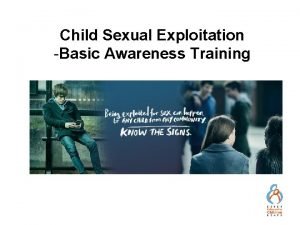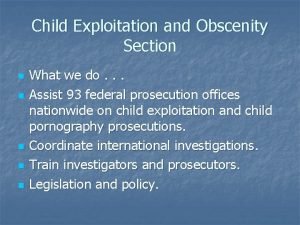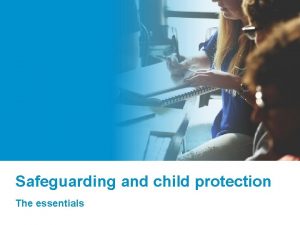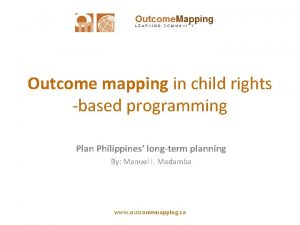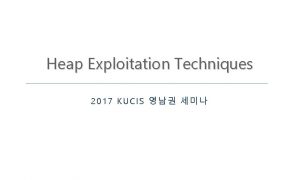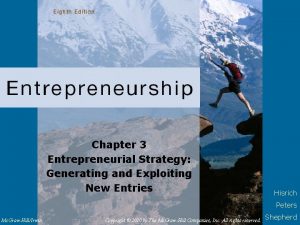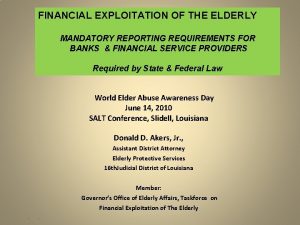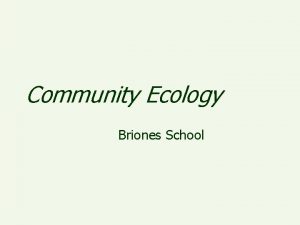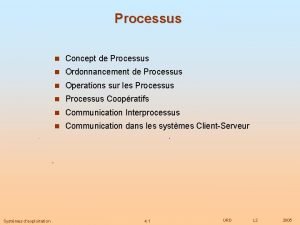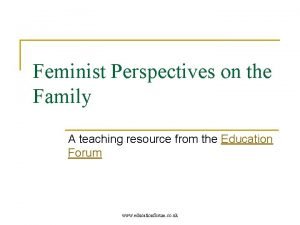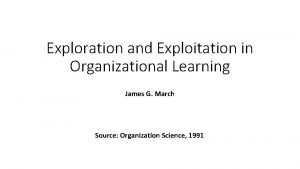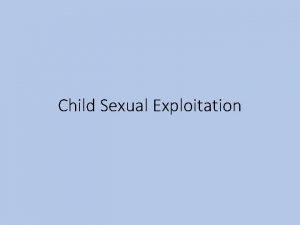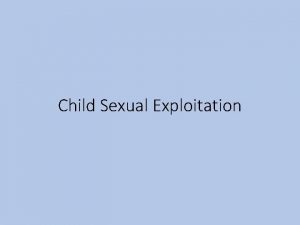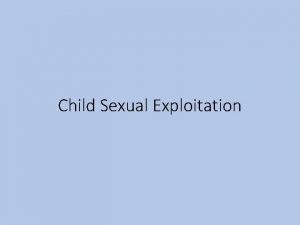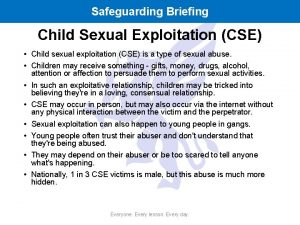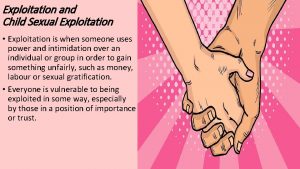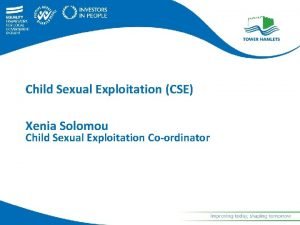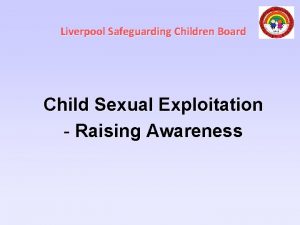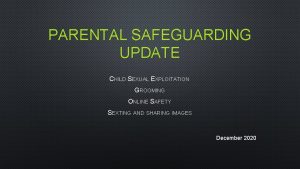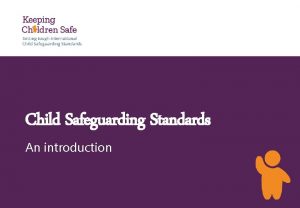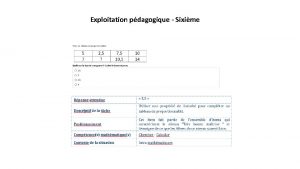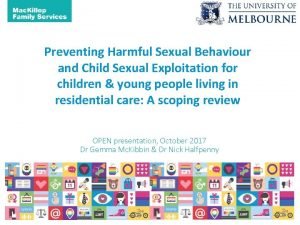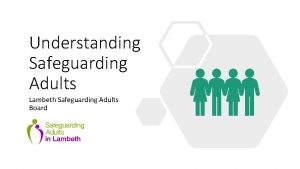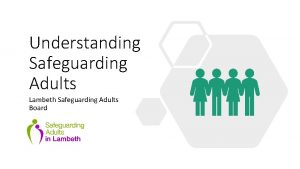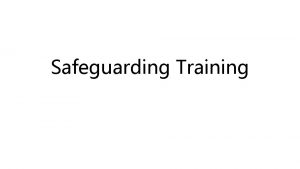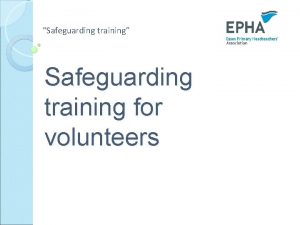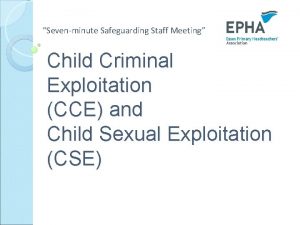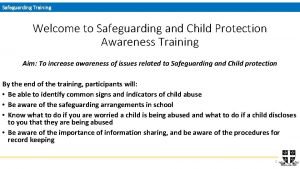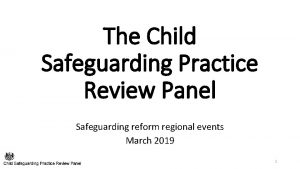Safeguarding in Schools Forum Child Sexual Exploitation Clare




























- Slides: 28

Safeguarding in Schools Forum: Child Sexual Exploitation Clare Livens – Child Exploitation Project Manager, Essex Safeguarding Children Board Kay Harrop - Lead for Child Sexual Exploitation, ECC Children & Families 1

The Essex Picture q 3 rd of all risk records in Essex are High risk/Victim q Just over three quarters (77%) of children identified as at risk of CSE are female, in comparison to previous figures which were at 89%. This means there has been increased reporting of the number of males identified as at risk of CSE, with the largest increase in male reporting being seen in the Mid quadrant. q Children at risk of CSE most commonly come to the attention of authorities aged 14 -15 q The prevalent risk models are “older adult boyfriend/girlfriend model” and “individual peer on peer”. There is little variation in models of CSE across all risk levels. 2

According to the Child Exploitation and Online Protection Command (CEOP) the amount of time 8 -11 years are spending online has more than doubled since 2005, meaning children within this age range are at increasing risk of online child sexual exploitation (OCSE). In 2016 Essex Police reported that over half its CSE crimes was in relation to images (cyber-enabled) Schools Survey: 81% of Year 6 children had phone with access to the internet / 95% of Year 8. High numbers of children reporting that they know another child has met up directly with someone they talked to online. 3

www. cse-toolbox. uk

www. cse-toolbox. uk • Guidance • Using the CSE Risk and Vulnerabilities Assessment • Including Explanations and Illustrations • Working with victims • Reporting to the police • Working with suspects • Access to CSE Risk and Vulnerabilities Assessment (download) • Access to a Risk Management Plan (download) • Sharing information with Essex Police

CSE Toolbox Online Training • ESCB Website • Learning & Development page • Child Sexual Exploitation • SET CSE Toolbox Online Training Free course to support staff and increase confidence in undertaking the new CSE Risk and Vulnerabilities Assessment contained within the Toolbox

CSE Risk and Vulnerabilities Assessment Who is Involved? Indicators of Actual CSE Indicators of Suspected CSE Vulnerabilities Checklist Summary Overall Level of Risk 7

How is risk ‘assessed’ for CSE? • There are no indicators that the child or young person is associating with individuals and/or groups who are either suspected of or known to engage in the sexual exploitation of children or young people, however there are specific vulnerabilities or specific aspects of the child's or young person's thinking, Standard behaviour, appearance, possessions and/or situation that give cause for concern, and this increases their vulnerability to being targeted and groomed for sexual exploitation • There are indicators that the child or young person is associating with subjects suspected of involvement with CSE and they may be targeted for Medium opportunistic sexual abuse as a result of this and their vulnerabilities High • There are indicators that the child or young person is associating with subjects known to be involved in CSE, and they are likely to be subject to sexual abuse as a result of this. • There are indicators of actual sexual abuse in the case. ACTUAL 8

CASE STUDY – Emily’s Story Emily is 14 years old. She has 9 year old brother called Shane who has an identified learning difficulty. She and her brother live alone with their mother. They do not have a close family network. Emily recently had a fixed term exclusion due to her behaviour in school. Last weekend, Emily was reported missing by her mum when she didn’t return home. She said she was with her mates. Emily’s friends are important to her. Mum has been told by neighbours, this group of young people are trouble. Emily and her family have recently moved from another authority due to a domestic incident between Emily’s mum and dad. Emily and Shane have a fractured relationship with their father. Shane was very sad about moving as he had lots of friends at school. Shane had 10 hours a week 1: 1 via his Education Health Care Plan. 9

STANDARD RISK 10

CASE STUDY – Emily’s Story Emily goes missing again. Emily’s mum is very worried and she and Shane go searching the local area to try to find her. Emily is eventually brought home by police who tell mum she is associating with older young people of concern. The police talk to Emily about trying and discontinue her associations as these young people have previously been linked to an incident where a house was attended by police where there was a party taking place. Police dispersed the party and they found evidence of drug and alcohol use and had concerns that activities at the address may have involved exploitation. 11

MEDIUM RISK 12

CASE STUDY – Emily’s Story Emily goes missing again a few weeks later. Emily tells her mum she is staying at a friend’s. Emily’s mum finds this not the true and Emily has gone to a house party. Emily was found by police with a 19 year old male called Tom in a bedroom at the house party. Emily says she can do what she likes and referred to Tom as her boyfriend. It was later identified that Tom has served a custodial sentence inciting young people to engage in sexual activity. Emily did not make any disclosures and no evidence was found of sexual activity between Emily and Tom 13

HIGH RISK 14

CASE STUDY – Emily’s Story Emily goes to school and tells her teacher that she is worried she might be pregnant. Emily tells her teacher that Tom will support her as he is the one who looks after her, not her mum. Emily tells her teacher that Tom buys her clothes, gifts and gives her money. Emily’s mum is distraught and tells school that she is struggling to cope with Emily and her behaviour is impacting on Shane, because of all the stress the family are under. 15

ACTUAL CSE 16

Essex CSE Arrangements 1 -Pager 17

18

What Have Children & Young People Told Us. . . Ask them regularly if anything is bothering them on social media – maybe do check ups on what they are doing depending on how much you trust your child. Parents can teach their children to be safe online and recognise the bad signs Talk with them regularly and say, “if you need to talk you can trust me”… 19

Educate young people on what CSE is and how to tell if you are being taken advantage of. Also offer help on how to resolve the issue 20 “. . teachers should have lessons about unhealthy relationships and also have a session with children who think they are in an unhealthy relationship and tell them what to do to stop it. ”

FEEDBACK WHAT DOES IT TELL US: q There is a lack of understanding of CSE by children and young people q. Normalisation q. CSE is this language children use? q. I made a choice q. Awareness of grooming techniques q Parents are key for keeping children safe ‘online’ q Significant risk taking behaviours ‘online’ q Children will seek help from their parents, school communities and police. q Children and parents place an importance on the role of schools as a source of help / advice / education 21

SUPPORTING SCHOOLS AROUND CSE q NATIONAL WORKING GROUP q. GOLD MEMBERSHIP (Apply via ESCB website, learning & development pages, CSE) q. CSE RESPONSE UNIT q ESCB CSE BULLETIN Online bulletin (quarterly) Accessible through ESCB website CSE / Professional pages. 22

SUPPORTING SCHOOLS AROUND CSE q ESCB Key Stage 2 Lesson Plans: q Relationships q Online Safety q Talking about Feelings q ‘I Didn’t Know’ Pledge q ESCB Key Stage 3 Lesson Plans: q Exploring Relationships q CSE Risks On and Off Line q The Grooming Line q Consent q Creating Your School Pledge 23

SUPPORTING SCHOOLS AROUND CSE q Training options for School Staff q NWG CSE Awareness E-learning q SET CSE Toolbox Online Training q CSE Basic Awareness Package q Missing Children Basic Awareness Package q NWG Gold Membership – subsidised training available: q Advanced & Foundation Training Packages q Gang awareness Training q Missing & Return Interviews Training q National Referral Mechanism q Specialist area training & conferences q CSE Champion Forums & bulletin updates 24

SUPPORTING SCHOOLS AROUND CSE q Other Support: q ESCB Website – CSE pages q Getting Help – range of organisations (national and local) q Professionals q Children & Families Consultation Line. q SET CSE Toolbox q SET CSE risk and vulnerabilities assessment q SET Risk Management Plan q Chelsea Choice (delivered in Sept / Oct 2017) q Regular updates through Schools Safeguarding Forum q I Didn’t Know CSE Campaign Resources 25

SUPPORTING SCHOOLS AROUND CSE q CARE project (The Children’s Society): secondary age pupils (11 -17 years) providing group work for up to 10 young people. Help young people to increase knowledge of CSE, protective factors and resilience, and lower the risk of CSE q Having Fun or Losing Control, The Involvement Team (Family Operations, ECC): pupils aged 13+ where there is an identified risk of CSE. Peer led programme, it has been developed using nationally recognised CSE training materials with young people q Blurred Lines, The Involvement Team (Family Operations, ECC) 1 Day Workshop, delivered to boys and young men 13+ where there is an identified risk of CSE. 26

SUPPORTING SCHOOLS AROUND CSE q Choices and 121 work, The Involvement Team (Family Operations, ECC) 6 week programme (small groups or 121). Choices group work for 13 yrs+ q Essex Youth Service (ECC) Programme/work must be commissioned by the school. The Essex youth service CSE programmes are planned to suit the schools individually required needs (cost dependent on programme). q Crucial Crew (delivered in some Districts in Essex) Year 6 pupils an interactive way that teaches personal safety. q www. railwaychildren. org. uk/schoolresources 27

SUPPORTING SCHOOLS AROUND CSE q Risk Avert Secondary-age pupils (primary age programme being developed for later 2017). Risk-Avert identifies young people vulnerable to multiple risk-taking behaviours and offers universal and targeted intervention. q Essex Fire & Rescue Service Cyber Safety programme to year 6 pupils, covers: • Online grooming • Cyber Bullying • CEOP • Sharing inappropriate material • Identity theft 28
 Definition of sexual exploitation
Definition of sexual exploitation Child beauty pageants harmful
Child beauty pageants harmful Child exploitation and obscenity section
Child exploitation and obscenity section Definition of child exploitation uk
Definition of child exploitation uk Safeguarding and child protection the essentials
Safeguarding and child protection the essentials Child safeguarding standards
Child safeguarding standards Reach safety target
Reach safety target Huntsvillecs.powerschool.com
Huntsvillecs.powerschool.com Sheffield schools forum
Sheffield schools forum Sheffield schools forum
Sheffield schools forum Child protection policy
Child protection policy Bilan d'ouverture
Bilan d'ouverture Image analysis and exploitation
Image analysis and exploitation Heap exploitation techniques
Heap exploitation techniques Nf p 06-004
Nf p 06-004 Windows heap exploitation
Windows heap exploitation Exploitation plan meaning
Exploitation plan meaning Q learning exploration vs exploitation
Q learning exploration vs exploitation Key impact pathways horizon europe
Key impact pathways horizon europe Risk reduction strategies for new entry exploitation
Risk reduction strategies for new entry exploitation Exploitation of the infirmed
Exploitation of the infirmed Exploitation competition
Exploitation competition Système d exploitation
Système d exploitation Where did the first consumer movement began
Where did the first consumer movement began Systeme d'exploitation
Systeme d'exploitation Exploitation
Exploitation Exploration and exploitation in organizational learning
Exploration and exploitation in organizational learning Systeme d'exploitation
Systeme d'exploitation The generation and exploitation of new entry opportunities
The generation and exploitation of new entry opportunities
